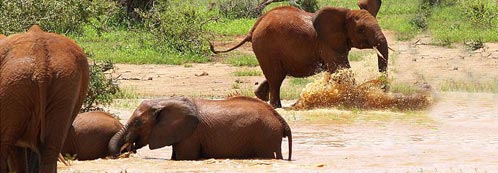Field Notes
January - April 2014
The Tsavo Elephant Aerial Count was conduct by the Kenya Wildlife Service in early February. It rained during the count which has happened during previous counts. A total of 11,076 elephants were counted within the 48,656 km2 ecosystem; a decline from the 2011 count of 12,573 individuals in an area of 48,319 km2. I am always responsible for data collection and was discouraged by the number of carcasses and bones I was recording. But, then in one survey block, I saw two well known bulls, Eli and Thunder, in a group of 10 bulls.
Although it rained in January the heaviest rain was in February through March. Since Tsavo elephants have large home ranges and they move to areas where the vegetation is green it was often difficult to anticipate where the bulls and families would be located. Many Pallid and Montagu's Harriers were seen this year swooping over the glades in the bull area. The Barn Swallows and Eurasian Rollers that arrived in Tsavo last year in November left Tsavo in mid-April. In the bull area there was an aggregation of 67 Eland and a lone Topi was with a group of five Fringe-eared Oryx.
Bulls
With the exception of a few small groups of young bulls, most of the older bulls were not in the bull area from January through March. In April they started coming back alone or associating in small groups. Livingstone was one of the few older bulls in the area. In January he was in musth, a first, since his typical musth cycle is during the dry season. He was with Jezebel's family on the crest of a hill feeding on grass and vines. Two young males, 6-8 years old, crossed the road to feed, but the family did not follow. I moved back out of their way, and turned off the engine. A van approached and Livingstone moved to the center of the road and stopped. Then another van passed by me and approached from the other direction. Livingstone stood with his ears out and trunk curled toward the first van and prevented both vans from passing. He tossed soil with his trunk a few times and flapped his ears but even with the engines running he did not move. After the two young males went back across the road and joined the family Livingstone moved away from the road. It appeared as if he wanted to prevent the vans from separating the family members.
Ripley, a 24 year old bull, was alone a few times in February then in early April he was with Evergreen's family resting under a tree. When he decided to head toward a waterhole two young males, 6-8 years old followed and a few minutes later Evergreen and the rest of the group followed. It wasn't until they moved from behind the bushes that I saw that her entire group of nine consisted of young males, from five to ten years old. The waterhole they were headed toward was the size of a small lake and deep, perfect for swimming. The young males dived in and when Ripley went in he is so big that he created waves and caused a panic when the water rushed over their heads. Ripley slowly swam toward them and at first they rushed to the bank, but they must have realized that there wasn't really a threat because they turned and swam toward Ripley. They slapped their trunk on the surface, trumpeted underwater, swimming one way and turning around and swimming back. When Ripley left the waterhole the males followed, when he turned around and went back into the waterhole, they were right behind him. Meanwhile, after Evergreen got a drink and splashed water behind her ears, she moved nearby to feed. Ripley and the males played for over an hour, then when Ripley climbed out all the young males followed.
Families
With good rains and widespread resources, families move around their large wet season range and I never know who I might see. In January, I was concentrating on the identification of two young bulls at a waterhole, when I heard trumpeting at the base of a hill and within 10 minutes families and bulls were approaching the waterhole from all directions. First Hazel's family came from the south, and then Nola's family came from the north followed by a bull (35-40 years old). As they got close to the waterhole Nola stopped and waited for the bull, while the rest of her family continued forward. When the bull got near her, she turned and walked to the waterhole with the bull following. Over the next 30 minutes more families and bulls arrived and soon there was an aggregation of 100 elephants; drinking, splashing, rumbling and trumpeting.
In March, Eldora's family returned to the western region and Skye's calf born last year was healthy. Tessa's family has not been with Eldora's family for two years now. She may have changed her association and ranging patterns. In late April, Primrose was in estrus, in an aggregation of 64, in a bush-grassland habitat. A non-musth bull, 25 years old, stayed close to her. Usually when a female is in estrus with a bull, one of her calves, the youngest, stays with her. But, it appeared that she was separated from her offspring. The families were spread out and not in discrete units so her family was most likely nearby. Also in the aggregation was a musth bull, guarding a female and challenged two young bulls (20 years old) when they approached the female. Like the aggregation at the waterhole in January, I stopped collecting data and just watched.
May - August 2014
May through July was cool and windy and by August the temperature started to rise. In some areas it rained from May through August. Although most waterholes were dry by June, others had drinking water up to early August. Elephants aggregated in May and June with groups of 50 to 140 individuals consisting of families and bulls. While searching for bulls I saw a young Caracal, a rare sighting, trotting along the road toward a waterhole.
World Elephant Day - 12th August
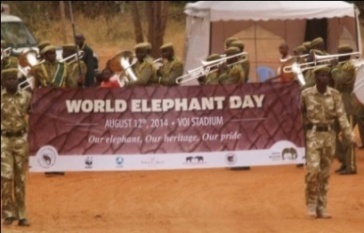
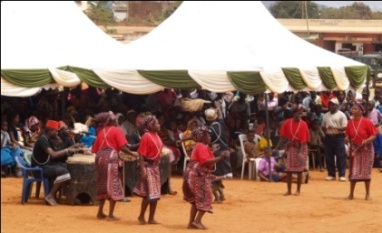
We celebrated World Elephant Day in Voi, the town adjacent to Tsavo East National Park, with a parade and Taita Dancers. The parade included the Kenya Wildlife Service Band, school groups and conservation organizations. At the stadium speakers talked about the impact of poaching on the Tsavo elephants, community security and tourism.
Bulls
In May and June most bulls were either alone or with families. In May, Nathan was in musth with a family at a waterhole. He had broken-off one-third of his right tusk. As this group left the waterhole and traveled across an open glade, Arrow suddenly appeared from the bush and followed them across an open grassland habitat.
In May, Sun was with four bulls swimming at a waterhole. When I saw him in April he had large clumps of mud on the tips of his tusks. But, now with the mud washed off I could see that both tusk tips were broken-off. This is the fifth bull that had newly broken tusks over the past year. Both bulls and females use their tusks to dig for tubers in the ground and dig-up and eat soil for salts and minerals in the soil, so these bulls may have broken their tusks while digging.
In July bulls began association with other bulls in groups of two to nine bulls. The bull area where I conduct most of my research is not an exclusive bull area as many families also use the area seasonally. But, it is an area where bulls associate in large groups in the dry season and the same two to four bulls are together on numerous occasions year after year. In this area the number of newly independent males (10-12 years old), is increasing. Since there are families in the area it is not surprising that newly independent males are exploring the area on their own, but in close proximity to families.
Families
In May, Eldora's family was with four young males headed toward a waterhole and joined an aggregation of 58. Two to three young males are often with Eldora's family. They may choose to be near Eldora because as a matriarch (45+ years old) she has a wealth of knowledge about the environment; resources and safe areas that a newly independent male can learn from.
In May One Tusker's family and Cypris's family were together in an aggregation of 72 at a waterhole, where calves were splashing and swimming. In late-May Holda's family and Hazel's family were together headed to the same waterhole with C.T.'s family of three tuskless adult females following them. Once they arrived at the waterhole the three families merged with all the calves splashing and kicking water creating waves.
In June Mango's family was at the same waterhole when a Fish Eagle swooped down from a Baobab to the side of the waterhole startling the family. They moved away from the eagle, then stopped and turned back facing the waterhole. A young female in the family (12 years old) slowly headed back to the waterhole then when the rest of the family followed she charged the eagle and trumpeted, when the eagle flew away the family went back into the waterhole to swim and splash. In July Norah's family was at the same waterhole. This sighting was a wonderful surprise since I had not seen her in several years. Her tusks are now long and crossed; distinctive features that will help in future long-distance recognition.
September - December 2014
The unusual rainfall patterns continued from September through December. In September there were several storms and as is typical of the Tsavo area within 72 hours many areas were green, but most waterholes remained dry. October was hot and the vegetation began to dry but when the rains started again in mid-November the vegetation turned green again and waterholes began to fill. In early December storms moved into Tsavo and within just a few days all the waterholes were full to overflowing. In September three Crested Cranes, male, female and young were sighted at a waterhole. In late November, I found a group of 42 Giraffe spread-out across 400 meters. Most of them were feeding on Acacia while others were watching me. Also in November, large flocks of Barn Swallows arrived in Tsavo and in December several Eurasian Rollers, Pallid Harriers and Steppe Eagles were in the bull area.
Bulls
In September and October Sandstone, Knox, Sunray and Ripley were in bull groups of four to eight bulls. Skylight appears to prefer the western region during all seasons, as I see him almost every field day. During November and December almost all of the known bulls had moved to other areas. I've been searching for Darwin for many months and was relieved to hear from a pilot that he saw Darwin in mid-November and that he was healthy. He was in an area with no roads and thus I was unable to find him.
Many of the groups in the bull area between September and December were newly independent males. Most of these males had smooth ear-edges and symmetrical tusks but some of them had distinct features (ear notches/holes, one tusk) so I could take identification photos. Once I see an individual twice and I have a clear feature-photograph I name them. Easier said than done; an elephant name must “fit” the individual and help to re-identify them during future sightings.
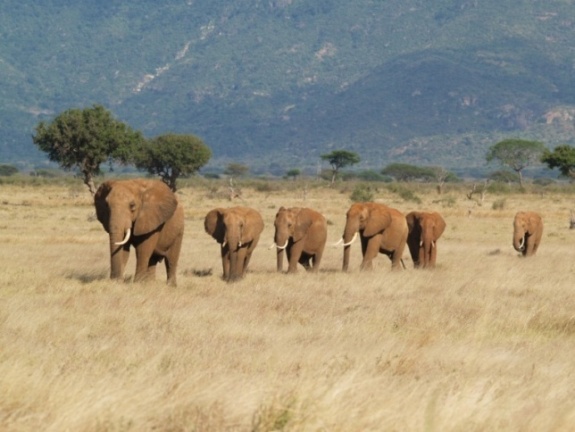
One aspect of the bull research is to determine the relationship between age and leadership. Leadership in this context refers to group dynamics. Specifically do young bulls in a group orient themselves in relation to older bulls, change their activity to match an older bull's activity or follow an older bull?
In September, Riley, single left tusk, was with a group of young males. As they moved across the open grassland the youngest male (second in line) moved ahead of Riley (oldest male), but when he got to the road he stopped and waited for Riley to catch-up. When Riley met him they crossed the road together, then Riley moved forward and was once again in the front of the line.
Families
Although it rained in areas outside the western region in September many families and bond groups (Eldora-Skye, One Tusker-Cypris, Tiberia-Tamika, Medora, Jezebel, Miranda and Savanna-Summer) remained in their dry season range until November. When the rains were widespread almost all families expanded their range. In September and October several newborns were recorded.
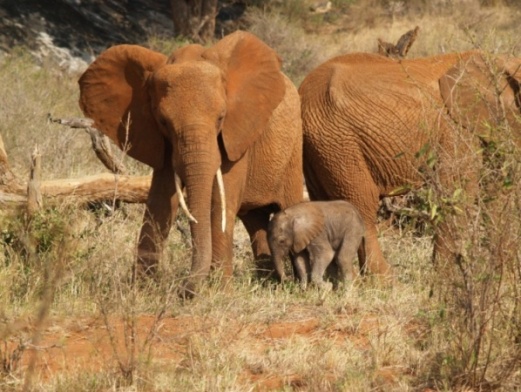
On the 20th of September, Savanna's family and Summer's family were together and Summer had a female newborn, 2-3 days old (photo-left). Then 17 days later, on the 7th of October, Savanna had given birth, another female. They were traveling east at the base of a hill in a tightly bunched group surrounding the two newborns. Summer's newborn was a bit unstable but she was able to keep pace with the family. But, Savanna's newborn had some difficulty walking through a rocky area and couldn't climb over a large rock. The family became alarmed at the situation and everyone stopped, surrounded both newborns and rumbled. Savanna turned and encircled her trunk around her newborn's torso and helped her climb over the rock. Then when both newborns got to a flat surface they continued along an elephant path heading east.
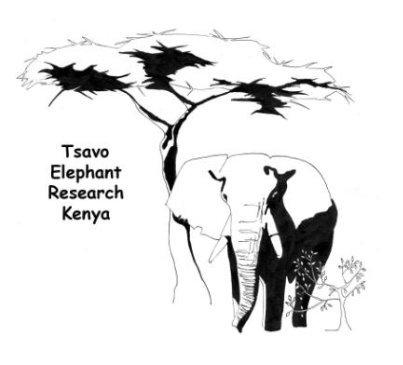
Tsavo Elephant Research Needs Your Help.
Donations are needed to continue this 30+ year field study
and support a Kenyan research field team.
We monitor the behaviors of Tsavo known bulls and families:
group dynamics, offspring & survival, musth cycles and habitat use.
Please click here or on the donate button
to send your donation.
Thank you!
Barbara
